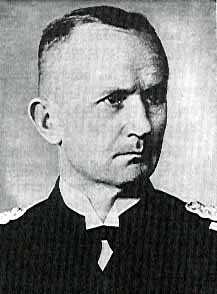- Author
- Hume, A.R.N., Midshipman, RAN
- Subjects
- Biographies and personal histories, WWII operations, History - WW2
- Tags
-
- RAN Ships
- None noted.
- Publication
- March 2006 edition of the Naval Historical Review (all rights reserved)
‘Admiral Doenitz was a great naval officer; our main regret should be that he was not on our side. He and a few thousand men in submarines came very near to defeating the Allies through the interdiction of our sea lanes.’
Admiral Raymond H. Bass, Submarine Commander, World War II
Introduction
Grand Admiral Karl Doenitz is considered by many as one of the greatest naval tacticians and strategists of WWII. His vision, integrity and pioneering tactics in Submarine warfare came close to costing the Allied powers final victory in Europe.

A native son of Germany, Doenitz was born on 16 September 1891 in Grunau bei Berlin. He received his commission as an officer in the Kreigsmarine (German Navy) in 1913 and saw active service as a submarine officer in both world wars. In 1935, Admiral Raeder, the Commander-in-Chief of the Kreigsmarine, tasked Doenitz to begin a covert build-up of German submarine strength in direct contravention of the Treaty of Versailles. With the outbreak of hostilities in 1939, Doenitz, with limited capability and resources, nearly succeeded in isolating the British Isles from resupply via the U-boat blockade.
His leadership, innovation and dedication whilst commanding the U-boat arm, and eventually the entire Kreigsmarine, made a significant contribution to achieving Germany’s wartime goals in the European Theatre.
His most significant achievements and failures
After the outbreak of hostilities in the Atlantic, Germany’s initial success against merchant shipping pressured Allied forces to invent new means to counter the growing U-boat threat. This saw the development and introduction of the convoy system, radar, improved Asdic and several other advances in anti-submarine warfare and maritime asset protection.
These improvements were the direct result of tactics employed by U-boats under Doenitz’s direction. From this, Doenitz indirectly facilitated the creation of these technologies and tactics.
With the advent of the convoy system, individual U-boat attacks soon became ineffective. Pre-war exercises and advances in submarine technology allowed Doenitz to introduce the concept of multiple submarines attacking simultaneously, which soon became known as ‘Rudel’ or wolf packs. Shortly thereafter, Allied losses increased significantly and the prospect of losing the war became very real. In the period of May to October 1942 alone, U‑boats sank 287 ships with a total of 1,450,878 tons. It was during these years that Doenitz’s flexibility when directing operations allowed him to maximize the assets available to him, thus keeping the Allies constantly on the defensive.
When considering the maritime conflict, Doenitz wanted to avoid direct confrontation with Allied surface ships and air assets, due to their superiority over the German surface fleet. He chose instead to concentrate offensive operations on what Germany correctly perceived to be Britain’s greatest weakness: the vulnerability of her merchant fleet. The loss of these vessels combined with an effective U-boat blockade would have removed Britain from the war and denied Allies a launch point for a Western Front against the Reich.
By favoring a submarine-oriented Kreigsmarine, Doenitz overcame the strengths of the Allied forces, and minimized the logistical and resource problems of basing a surface fleet in the Atlantic. As the resources and time required to construct, base and maintain a submarine were significantly less than for a warship, Doenitz was able to field an increasing number of U-boats in a short time.
Doenitz constantly campaigned for greater resources to be dedicated to U-boat production and research. Combined with his comprehensive training requirements, he aimed to provide his men with the best equipment and weaponry possible. By the end of the war, German submarine technology was unparalleled. This level of expertise was evident in the production of the next generation diesel-electric submarine, the type XXI U-boat. These vessels were developed too late in the war to alter the outcome, although when captured by Allied forces, they became the model for American and Soviet submarines for years to come.
Doenitz unwittingly aided in the destruction of many of his own vessels. His command and control system required constant communication with his platforms, often requiring contact up to seventy times a day with a single U-boat. The triangulation of radio transmissions when reporting their situation, combined with Allied ability to read submarine communications, led to many vessels being located and destroyed.
His leadership style and how successful was it?
Doenitz achieved an unprecedented level of success against the Allies when commanding Germany’s U-boat flotillas during WWII. This however did not stem solely from a dynamic personality, but rather from his style of leadership. Doenitz believed in well-considered strategy, innovative tactics and the best possible training and equipment for his men. Being placed in charge of a disheartened submarine arm and implementing these beliefs, saw a change to a highly trained, motivated and capable implement of Reich policy, which came close to altering single-handedly the outcome of the war in Germany’s favour.




